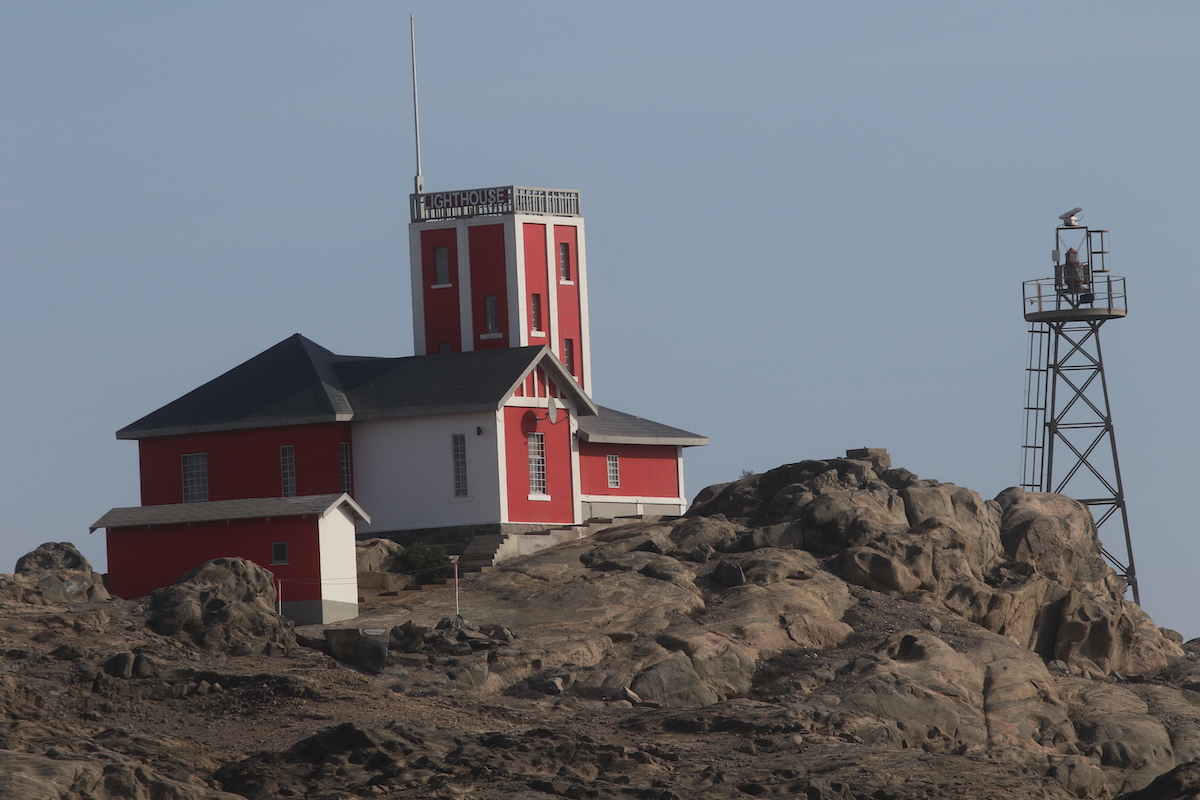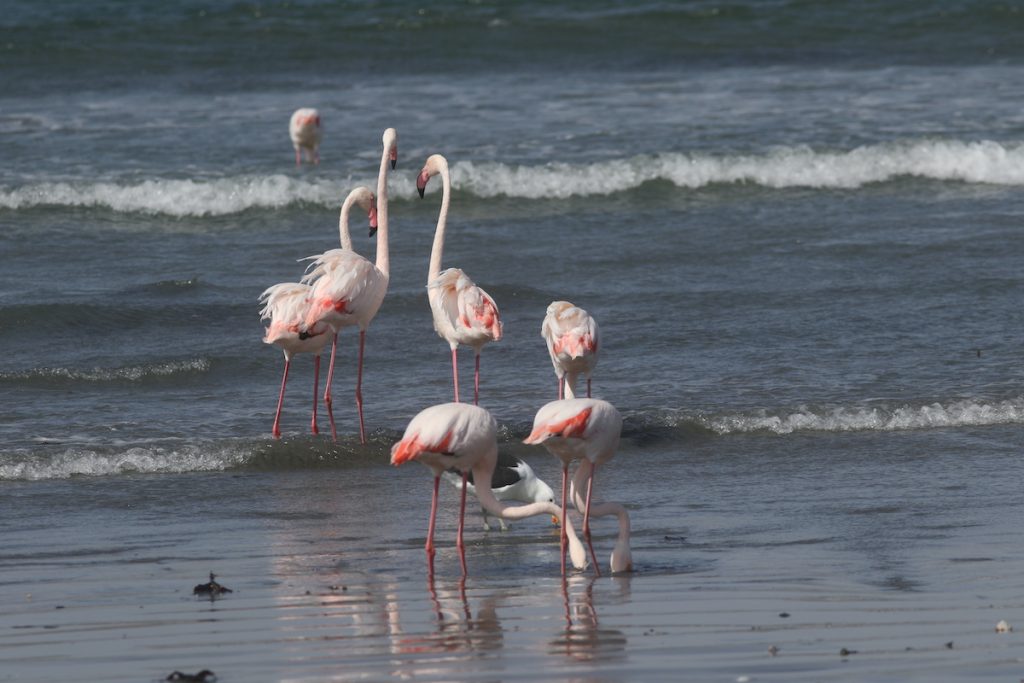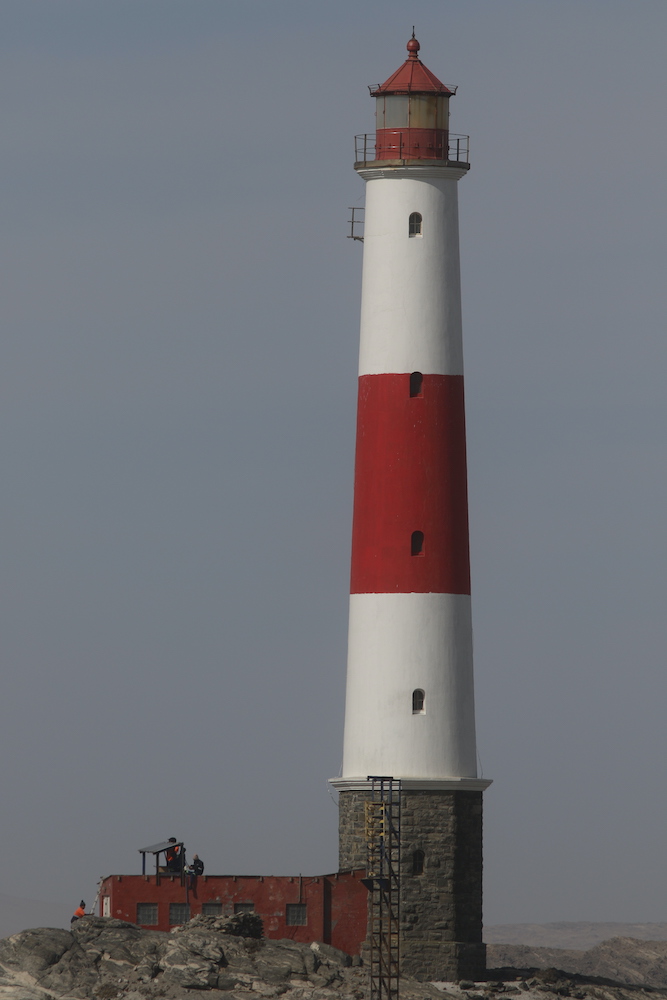The Benguela Beacon of Southern Africa

The lighthouse towered prominently atop a desolate, wave-battered, weather-beaten crag in a remote region of southern Namibia. Surrounded by whitecaps, it seemed like a great place to construct a lighthouse.
But what doesn’t feel far-flung in this desert country of Southwest Africa? There’s just over two million people living in Namibia, making it the second least populated country in the world. That brightly colored red and white lighthouse near the historic German enclave of Luderitz, felt almost as far away as anywhere I’d been on the planet.
The Dias Point Lighthouse overlooked the frigid Atlantic Ocean and the seemingly always turbulent Benguela Current that travels north above the western cape of Southern Africa. Surely, back in 1488, Portuguese explorer Bartolomeu Dias, had no idea the barren, coastal desertscape he claimed for King John II, would also be the same site for a lighthouse finished in 1915. The Namibian coastline is one of the least hospitable coastlines in all of Africa.
Originally, Dias had orders from the Portuguese king to sail further south to the rugged yet breathtaking Cape of Good Hope at the southern fringe of Africa. However, early expeditions being what they were, Dias was blown off course, but on his return to Portugal, Dias landed at what is now known as Luderitz Bay. Today, the Dias Cross is one of the longest standing Namibian attractions, and it’s a national monument. It marks the spot where Portuguese explorers first set foot on the coast in 1488, coastal Luderitz seemingly a stone’s
throw away.
On the Water
As my girlfriend, marine biologist Holly Lohuis, and I meandered through the hustle of the busy port, cargo ships and fishing trawlers alike gently rocked against sturdy docks. As persistent morning fog gradually lifted and swirled, building northwest winds filled in. We caught an 8 am wildlife cruise on a catamaran out of the bustling harbor that also offered great views of the weathered lighthouse. The harbor was hopping with fishermen and cargo destined to be transported around the treacherous cape, but also up the southwest coast of the
African continent.

The rugged landscape surrounding the lighthouse appeared barren, lifeless – a coastal desert moonscape that was smothered in ripe seabird guano. Still, the waters surrounding the lighthouse were teeming with massive bait balls of fish. Thousands of raucous cape fur seals were hauled out on craggy rock outcroppings as large waves exploded on impact. Many more pinnipeds were in the chilly Atlantic, bobbing and foraging in heaving seas.
With the Dias Lighthouse as a backdrop, hundreds of frantic cormorants flew off the bow of the catamaran. Groupings of South African penguins and feisty terns feasted on the plentiful bounty within the dense kelp forests. From the catamaran, Heaviside’s dolphins breached the capping seas, and enjoyed the mild boat wake cresting off the stern and bow of the catamaran. Once the catamaran left the pelagic food chain, we motored in and out of protective coves surrounding the lighthouse of Dias Point.
Touching Down
In the 15th and 16th centuries it was traditional for Portuguese mariners to prominently mark significant landfalls during exploration efforts. Dias’ crew erected a wooden padrão, to post Portugal’s presence within a region. The padrão resembled a cross/pillar, and was erected at prime geographical headlands, marine terraces, and
river mouths.
Miraculously, that rustic landmark withstood the test of time. Despite the frigid ocean air and consistently harsh sea conditions of that wind-groomed coast, Dias’ padrão survived for 300 long years. In 1825, the crew of the HMS Barracouta recorded seeing the weathered remains of the crumpled cross. Thirty years later, some of those remains were transported to the South African Museum in Cape Town.
Since then, attempts have been made, taking some of those old remnants to construct a new padrão. It took a while, but a replica was finally placed at the original site, appropriately carved from local dolerite, a stone used for construction that can endure Namibia’s burly weather systems. The new padrão was unveiled on July 25, 1988.
The Grit and Grind of Namibia

At dawn, the following day, we drove south through the maze of dirt roads leading to the Dias Lighthouse and Cross. We drove around the backend of several coastal wetlands before heading north toward the prominent headland where the lighthouse overlooks unpredictable sea conditions. The tide was still on the wane while traveling across vast tidal flats frequented by greater and lesser flamingos. Narrow gullies had trapped receding tidal waters allowing plovers and terns to forage in the shallows.
After reaching the shoreline south of the lighthouse, gale force winds were already sweeping down the coast as frothy whitecaps and dark, cobalt blue water dominated the horizon of the Atlantic Ocean. The powerful winds were piercing as we marveled at flamingos wading through knee-to-waist-deep surf, their brilliant pink feathers ruffled by the howling winds.
After arriving at the lighthouse, we made the short, easy hike to the bluff where the Dias Cross stood, 2,000 feet to the west of the lighthouse. From that vantage point, great views of the turbulent seas we experienced the day before from the catamaran seemingly never subsided. The lighthouse, painted in broad red and white bands, stood out just east of Dias Cross. It’s just over 92 feet tall, and almost 1,800 feet north of the lighthouse is the foghorn that is vital for signaling ships in pea soup fog along the rugged coastline. A fog signal tower is also nearby and is still in use.
After leaving Dias Cross, we walked out to the lighthouse as two black-backed jackals – looking over their shoulders – scampered away in front of us. They seemed more enamored with all the lesser flamingos wading nearby in rippling tidepools, and the throng of sea and shorebirds wading through puffy seafoam in front of the lighthouse.
The lighthouse was closed, but the few visitors we saw traveling overland across Namibia enjoyed the remote desertscape and solitude surrounding “the Benguela Beacon.” All walks of life gazing at the Dias Lighthouse, including a four-legged predator.
Even a marauding brown hyena momentarily peered upward at the height of the lighthouse. Maybe that roaming scavenger had been using the lighthouse for years as it found its way foraging across the vast coastal desert biome.







You must be logged in to post a comment.